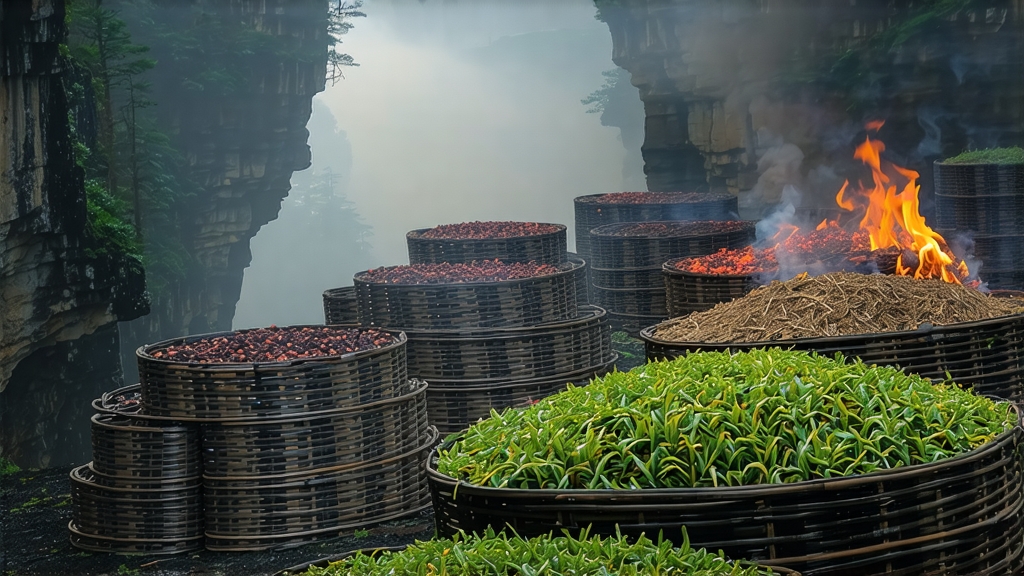
Long before Assam, Ceylon or Earl Grey entered the English lexicon, the first fully oxidised leaf that Europe would later christen “black tea” was already being fired over pinewood in the rugged Wuyi range of northern Fujian. Locals simply called it zhengshan xiaozhong—literally “small-leaf from the original mountain”—but the trading posts of Xiamen rendered it Lapsang Souchong, a name that still carries the perfume of ember and resin across five centuries. Today, when sommeliers speak of terroir-driven Chinese hong cha, they usually mean the sweet, malted elegance of Keemun or the golden buds of Yunnan; yet the original story begins with this smoke-kissed pioneer, a tea whose very aroma evokes the moment when Chinese green-tea craft pivoted into an entirely new category.
Historical records place the birth of Lapsang Souchong around 1568, late in the Ming dynasty, when a passing army commandeered the village of Tongmu during harvest season. To hasten drying and prevent mould, farmers spread the half-withered leaves over pine fires, inadvertently discovering that the smoke not only preserved the leaf but also imparted a flavour that travelled better than any green tea had before. Dutch merchants carried the first chests to Europe in 1604; by the time Catherine of Braganza popularised tea at the English court in 1662, “Bohea” (a corruption of Wuyi) had become synonymous with Lapsang Souchong. The East India Company’s ledgers show that even after the development of unsmoked black teas in the nineteenth century, the pine-smoked original commanded higher prices at the London auction than almost any other leaf.
Strictly speaking, only leaf picked within the 600–1,200 m core zone of Tongmu Nature Reserve may be called zhengshan (“original mountain”). Here, a subtropical monsoon climate shrouds granite peaks in fog for two hundred days a year, slowing photosynthesis and concentrating amino acids in the tender spring buds. The indigenous cultivar is a petite, slightly serrated strain of Camellia sinensis var. sinensis known locally as cai cha, prized for its low tannin and high fragrance. Outside the reserve, neighbouring townships produce waishan (“outside mountain”) xiaozhong from broader-leaf bushes; while still pleasant, the cup lacks the mineral core and lingering lychee sweetness that Tongmu’s weathered soils impart.
Plucking begins at Qingming, when one bud and two or three unfurling leaves are snipped above the scar of the previous flush. The morning’s pick is carried in bamboo baskets down narrow stone paths to wooden-louvered lodges where three sequential firings—withering, smoke-drying, and final baking—will transform green freshness into something far more complex. First, the leaves are spread 3 cm deep on bamboo trays suspended above shallow pits of smouldering pine embers. Temperature is kept below 80 °C so that moisture leaves the leaf gradually; over the next eight hours the green hue shifts to olive, then copper, as grassy volatiles give way to precursors of honey and fruit. Once the leaf is pliable enough to twist without snapping, it is rolled for 45 minutes in bamboo-ribbed barrels that bruise the cell walls and initiate oxidation. The rolled strips are then heaped in iron pans where they redden for two to three hours, the pile turned every twenty minutes to ensure even heat and humidity. What follows is the signature step: firing over a fresh pinewood blaze. Freshly split Masson pine, rich in resin, is stacked in a pit beneath a rattan rack; the tea master judges the exact moment when flames die back to embers, then shovels a layer of ash to moderate the heat. For the next six to ten hours the leaves absorb smoke in rhythmic cycles—five minutes exposed, ten minutes resting—until their moisture drops to 7 %. A final charcoal bake in closed bamboo ovens fixes the aroma and adds a whisper of toasted sugar. When done correctly, the smoke is not a mask but a veil, integrating with natural fruit esters to create notes of longan, dried persimmon and a cooling camphor finish.
Traditional Lapsang Souchong is graded by leaf size and proximity to the pine fire. Wuyi tea merchants still speak of three “ar